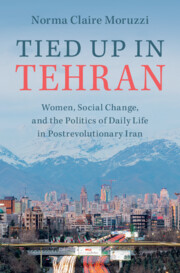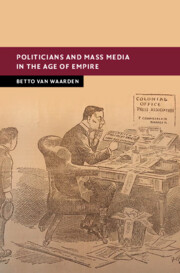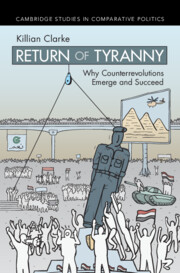Refine search
Actions for selected content:
265 results
Introduction
-
- Book:
- The Rise and Fall of Turkey's Democrat Party
- Published online:
- 23 October 2025
- Print publication:
- 06 November 2025, pp 1-24
-
- Chapter
- Export citation
1 - Young Ottomans: The Origins of the Democrat Party, 1908–1946
-
- Book:
- The Rise and Fall of Turkey's Democrat Party
- Published online:
- 23 October 2025
- Print publication:
- 06 November 2025, pp 25-60
-
- Chapter
- Export citation
2 - Children of the Revolution: Defining the Democrat Party, 1946–1950
-
- Book:
- The Rise and Fall of Turkey's Democrat Party
- Published online:
- 23 October 2025
- Print publication:
- 06 November 2025, pp 61-98
-
- Chapter
- Export citation

The Rise and Fall of Turkey's Democrat Party
- The Cold War and Illiberalism, 1945–60
-
- Published online:
- 23 October 2025
- Print publication:
- 06 November 2025
8 - Conclusion
-
- Book:
- Return of Tyranny
- Published online:
- 17 September 2025
- Print publication:
- 23 October 2025, pp 234-248
-
- Chapter
- Export citation
1 - Introduction
-
- Book:
- Return of Tyranny
- Published online:
- 17 September 2025
- Print publication:
- 23 October 2025, pp 1-17
-
- Chapter
- Export citation
Chapter 2 - The Politics of Press Consumption
-
- Book:
- Politicians and Mass Media in the Age of Empire
- Published online:
- 20 September 2025
- Print publication:
- 09 October 2025, pp 62-94
-
- Chapter
- Export citation
Conclusion
-
- Book:
- Politicians and Mass Media in the Age of Empire
- Published online:
- 20 September 2025
- Print publication:
- 09 October 2025, pp 349-369
-
- Chapter
- Export citation
7 - American Hierarchy and Its Discontents: Unpacking the Consequences for Partner States
-
- Book:
- Hierarchy and the State
- Published online:
- 20 August 2025
- Print publication:
- 02 October 2025, pp 138-160
-
- Chapter
- Export citation

Tied Up in Tehran
- Women, Social Change, and the Politics of Daily Life in Postrevolutionary Iran
-
- Published online:
- 28 September 2025
- Print publication:
- 16 October 2025
Conclusion
-
- Book:
- Killing the Messenger
- Published online:
- 05 September 2025
- Print publication:
- 25 September 2025, pp 191-194
-
- Chapter
-
- You have access
- Open access
- HTML
- Export citation

Politicians and Mass Media in the Age of Empire
-
- Published online:
- 20 September 2025
- Print publication:
- 09 October 2025

Return of Tyranny
- Why Counterrevolutions Emerge and Succeed
-
- Published online:
- 17 September 2025
- Print publication:
- 23 October 2025
Introduction
-
- Book:
- The Birth of Democracy in South America
- Published online:
- 04 June 2025
- Print publication:
- 07 August 2025, pp 1-16
-
- Chapter
-
- You have access
- Open access
- HTML
- Export citation
Chapter 2 - What Does the Term “School” Stand For?
-
- Book:
- School Adjustment
- Published online:
- 29 August 2025
- Print publication:
- 07 August 2025, pp 20-35
-
- Chapter
- Export citation
1 - Armies, Parties, and the Birth of Democracy
-
- Book:
- The Birth of Democracy in South America
- Published online:
- 04 June 2025
- Print publication:
- 07 August 2025, pp 17-47
-
- Chapter
-
- You have access
- Open access
- HTML
- Export citation
Conclusion
-
- Book:
- The Birth of Democracy in South America
- Published online:
- 04 June 2025
- Print publication:
- 07 August 2025, pp 302-316
-
- Chapter
-
- You have access
- Open access
- HTML
- Export citation
15 - Scope and Depth of International Legitimacy, Modernity, and the West
- from Part V - International Legitimacy and Change
-
- Book:
- The Law and Politics of International Legitimacy
- Published online:
- 14 July 2025
- Print publication:
- 24 July 2025, pp 283-300
-
- Chapter
- Export citation
2 - Identity in Context
-
- Book:
- After Equality
- Published online:
- 19 June 2025
- Print publication:
- 03 July 2025, pp 42-86
-
- Chapter
- Export citation
Impartial Administration and the Development of a Political Society of Compromise in Scandinavia
-
- Journal:
- Social Science History / Volume 49 / Issue 3 / Fall 2025
- Published online by Cambridge University Press:
- 11 June 2025, pp. 640-669
- Print publication:
- Fall 2025
-
- Article
-
- You have access
- Open access
- HTML
- Export citation
